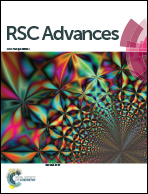Rational modifications on ruthenium terpyridine sensitizers with large Jsc for dye-sensitized solar cells: combined DFT and relativistic TDDFT studies†
Abstract
In this work, we designed a series of ruthenium sensitizers DX2–DX5 derived from a phosphine-coordinated ruthenium sensitizer DX1 with a surprisingly high short-circuit photocurrent density (Jsc) of 26.8 mA cm−2 for dye sensitized solar cells (DSSCs), with the aim of enhancing the light harvesting ability in the near-infrared (NIR) region and further increasing the Jsc. Density functional theory (DFT) and relativistic time-dependent DFT calculations have been performed to evaluate the optical and photovoltaic properties of these Ru dyes, taking the effect of spin–orbit coupling (SOC) into consideration. The intrinsic causes for varied Jsc and open-circuit photovoltage (Voc) have been systematically discussed through investigating the light harvesting efficiency, electron injection driving force, dye regeneration driving force, electronic coupling and conduction band energy shift. The calculated results reveal that the designed DX5 has increased light harvesting efficiency in the NIR region and a higher conduction band energy shift compared with other sensitizers. That is, DX5 may have improved Jsc and Voc, which makes DX5 serve as a promising sensitizer for future DSSC applications.


 Please wait while we load your content...
Please wait while we load your content...